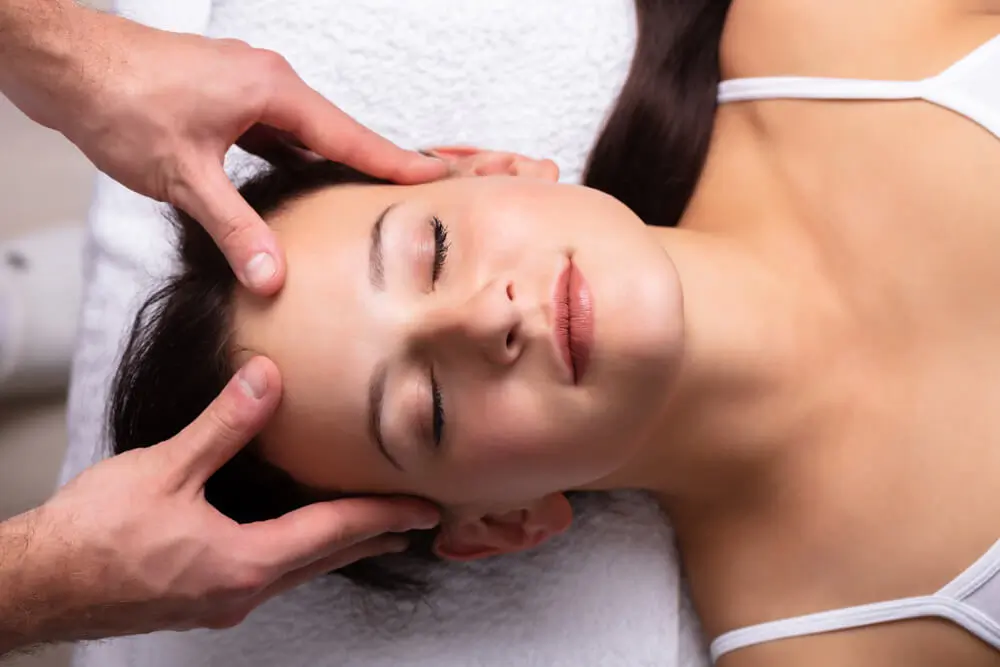When we encounter challenges and stressful situations in life, it most often radiates anxiety, stress, and unease. We are frequently faced with obstacles that take a physical and emotional toll on our mental health, and it is common to want to find a road to escape all of that. That is why massage therapy is highly recommended to reduce anxiety and calm our nervous system when we get anxious. James Lake, a clinical assistant professor, wrote on Psychology Today that “the anxiety-reducing and mood-enhancing benefits of massage are probably related to changes in EEG activity, decreased levels of cortisol, and increased activity of the parasympathetic nervous system…” (Lake). This is one of the many positive outcomes of massage therapy, as it promotes low stress and overall well-being.
There are two significant factors that come into play that we will focus on: anxiety and the nervous system. By definition, anxiety is an emotion characterized by worry, nervousness, and unease. At first glance, this seems like a mental issue, but it impacts physical health as well. According to author Shelly Turner from David Behavioral Health, there are many different physical problems that could arise from anxiety, such as high blood pressure, weight gain/loss, headaches, weak immunity, and stomach issues. It even causes sleep problems, as she writes that “A lack of sleep can cause weight gain, disrupt the immune system and even contribute to heart disease” (Turner). The idea of anxiety is that it affects us mentally first, which then unconsciously leads us to an unhealthy body because of bad habits we create along the way.
On the other hand, the nervous system is the part of the body that coordinates actions and sensory information by transmitting signals from different parts of the body. This system has two components: the sympathetic and parasympathetic system. The sympathetic system focuses on fight-or-flight responses, which is enabling alertness and cautiousness in stressful situations. Meanwhile, the parasympathetic system relies on rest-and-digest responses, promoting relaxation and maintaining energy. According to an article “Sympathetic vs. Parasympathetic and Why They Matter” from Experience: Health and Wellness Center, “If there is a miscommunication between your brain and the impulses that promote sympathetic responses, your body will be functioning in fight or flight mode far too often and for far too long, and this can have negative consequences on your overall health” (Experience). It is important to balance the concept of alertness and relaxation as it best maintains a healthy body with low stress. Overall, anxiety and the nervous system are two critical points that highly impact our physical and mental health, and our goal is to decrease that chance through treatments like massage therapy.
Reducing Anxiety
We often turn towards massage therapy looking to relieve physical problems such as aches, soreness, tension, and pain. But a factor that is equally important that massage therapy alleviates are mental stressors like anxiety. But how do massages reduce anxiety if it is focused on contacting physical parts of the body? The main points are that it helps reduce stress hormones, increases serotonin and dopamine, improves sleep, and promotes relaxation. The relevance of these four solutions are critical as its impact is a building block of reducing anxiety.
1. Reduced Stress Hormones
Stress hormones often peak when parts of the brain are triggered and begin sending signals to other parts of the body. Two parts of the brain essential to this concept are the amygdala and hypothalamus. The amygdala is the idea of emotional processing and fear responses, while the hypothalamus activates the fight-or-flight response and controls involuntary body functions. These two traits combined together lead to high stress hormones because of its alertness and attentiveness. An article “Understanding the Stress Response” from Harvard Health Publishing describes the effects of the amygdala and hypothalamus being activated.
After the amygdala sends a distress signal, the hypothalamus activates the sympathetic nervous system by sending signals through the autonomic nerves to the adrenal glands. These glands respond by pumping the hormone epinephrine (also known as adrenaline) into the bloodstream. As epinephrine circulates through the body, it brings on a number of physiological changes. The heart beats faster than normal, pushing blood to the muscles, heart, and other vital organs. Pulse rate and blood pressure go up. The person undergoing these changes also starts to breathe more rapidly. Small airways in the lunge open wide…Extra oxygen is sent to the brain, increasing alertness. Sight, hearing, and other senses become sharper…” (LeWine).
These factors are what leads to high stress hormones, involving parts of the brain that
connects to sensations and feelings. Enforcing massage therapy could help decrease these levels of activities significantly.
One way that massage therapy can reduce stress hormones is by lowering the amount of cortisol in your body. It reduces it by shifting your body’s attention from a fight-or-flight mindset to a rest-and-digest one, leading to lower stress and higher relaxation. According to an article called “Can Massage Relieve Symptoms of Depression, Anxiety, and Stress?” from the Mayo Clinic Health System, “This hormone is produced when your body is stressed. It increases glucose in your bloodstream, enhances your brain’s use of glucose and curbs functions that are nonessential in a fight-or-flight situation” (Marsolek). By focusing on parasympathetic functions, it helps increase that activity and lowers the sympathetic system levels.
2. Increased Serotonin/Dopamine
Serotonin and dopamine are two types of feelings that massage therapy attempts to achieve because it focuses on the mental and emotional well-being of customers. The goal is to have them leave their appointment feeling happier and more calm, and massages are able to enhance that emotion. To briefly define these terms, serotonin contributes to feelings of happiness, calmness, and emotional stability, while dopamine focuses on the reward system, motivation, and movement. The physical benefits of massage in regards to serotonin is simple. “This hormone neurotransmitter is sometimes called the “happy chemical” because it reduces feelings of depression and carries signals between nerves and your body. By lowering cortisol and increasing serotonin, you’re boosting your body’s ability to fight off pain, anxiety and feelings of sadness” (Marsolek). Massages help relieve the tension and worry, and it emits a sense of comfort and peace, creating the aspect of serotonin and dopamine.
3. Improved Sleep
When we go to sleep, it is often with a relaxed heart beat, sense of safety, calmness, and relaxation. So how does massage therapy create good quality of sleep if we are already at a state of peace? This has to do with serotonin, previously mentioned above. It is the feeling of calmness and happiness that we strive to reach when we are unconscious.
According to an article called “Sleep Well: How Massage Therapy Can Improve Your Quality of Sleep” from Fulham Massage & Wellness, they describe how professional massages can promote good sleep. “Massage helps to combat insomnia by increasing the production of serotonin, a neurotransmitter in the brain. It is believed that the area of the the brain that facilitates the body entering into deep sleep uses serotonin to communicate. The brain also uses serotonin to produce melatonin, which is the hormone responsible for telling the brain to ‘slow down’ and to prepare for sleep” (Fulham Massage & Wellness).
As we know, melatonin is a sleep pill that assists with ease of sleep, so the body producing this hormone on their own with no outside additives is beneficial overall. There were also studies that brain waves are the heaviest, meaning they are in their deepest level of sleep, when a massage has been performed. Better sleep leads to reduced anxiety because it regulates stress hormones and emotional regulation, allowing our bodies to be at a calmer physical and mental state.
4. Promoted Relaxation
It is almost certain that after massage therapy, clients tend to be more relaxed than when they first walked in. It is because they have undergone relaxation techniques–in this case massage therapy–to reduce stress and manage their anxiety. According to the International Journal of Mental Health Systems, “Relaxation techniques are defined as ‘a set of strategies to improve physiological response to stress.’ The underlying treatment goal of all relaxation techniques is to use relaxation to decrease stress or anxiety” (Hamdani et. al). It is a series of steps: massage therapy leads to relaxation, which thus decreases anxiety. As well as through techniques such as reducing muscle tension and improving circulation, it helps increase relaxation to its extent, leading to a calmer state of mind altogether.
Calming the Nervous System
As discussed above, the nervous system is made up of two parts: the sympathetic and parasympathetic system. The overall idea is that we want the sympathetic system to decrease and the parasympathetic system to increase. We want to promote the rest-and-digest concept, and through massage therapy, creating the sense of calmness and no alertness to danger is one way to do so. A couple ways to calm the nervous system is through sensory receptors and improved circulation. These are only a few of many methods of creating peace of mind.
1. Sensory Receptors
We typically perceive the world through our sensation and perception, so it is the same with massage therapy. When someone is experiencing a relaxing sensation, they would lean towards a more enjoyable feeling. According to Neurodivergent Insights, “When a person is sensory regulated, they can more easily experience pleasure and satisfaction with various sensory experiences. They may seek out activities or environments that provide sensory input aligned with their preferences, such as enjoying the taste of certain foods or finding delight in the sights and sounds of their surroundings” (Neurodivergent Insights). This is the same idea with massage therapy: if someone is sensing something they like, they would perceive it as pleasure and happiness, so being able to regulate our emotions is critical to calming our nervous system, for us to reach the “pleasure” point.
2. Improved Circulation
In simple terms, improving circulation calms the nervous system through oxygen delivery and removing waste products, which reduces the stress hormones. This is because when blood flow is optimized, it reduces anxiety symptoms and improves the overall nervous system function. According to RST Sanexas, “The circulatory system brings nutrients and oxygen to the nervous system and moves hormones. The nervous system sends electrochemical signals throughout the body and the circulatory system moves our blood. Both bodily systems functioning properly to maintain overall good health is especially important” (Frayer). Improving circulation helps prevent clots and blockage, leading to ease of flow and better functioning in the body. By massaging the body, it creates better blood flow and allows more circulation.
Understanding the importance of massage therapy and how it reduces anxiety and calms the nervous system is significant because it motivates customers and clients to turn towards this method when wanting to destress. Massage therapy offers far more than just physical relief—it’s a powerful, evidence-based tool for restoring emotional balance and calming the nervous system. In today’s fast-paced, stress-heavy world, anxiety can manifest in both the mind and body, disrupting our ability to rest, focus, and feel well. By lowering stress hormones like cortisol, increasing feel-good neurotransmitters such as serotonin and dopamine, promoting better sleep, and directly engaging the parasympathetic nervous system, massage helps shift us from a state of survival to one of healing and recovery. Ultimately, investing in massage therapy is not just self-care—it’s a meaningful step toward reducing anxiety, calming your nervous system, and reclaiming a sense of inner calm amongst a hectic world.
At Cloud 9 Foot Spa, we are committed to delivering an exceptional experience where every client feels cared for and deeply relaxed. Our mission is to provide massage services that promote profound relaxation and improve sleep quality. One customer shared on Yelp,
“The acupressure on my feet was intoxicating, providing deep relief and relaxation—I almost fell asleep” (Nanci).
Our aim is to guide each client into a state of deep physical and emotional rejuvenation. By doing so, we fulfill our goal of creating a warm, welcoming environment that leaves every guest walking out with “happy feet.”
Works Cited
Body Mechanics. “The Role of Massage Therapy in Managing Anxiety and Depression.” Body Mechanics Orthopedic Massage : Sports Massage and Massage Therapy New York City, 8 Aug. 2024, www.bodymechanicsnyc.com/2024/08/08/the-role-of-massage-therapy-in-managing-anxiety-and-depression/. Accessed 27 June 2025.
Experience Health and Wellness Center. “Sympathetic vs. Parasympathetic and Why They Matter.” Experience Family Chiropractic, 1 Feb. 2018, www.efchealth.com/sympathetic-vs-parasympathetic-matter/.
Frayer, Joan. “How Does the Heart Cardiovascular System Work? | RST-SANEXAS.” RST Sanexas, 28 Feb. 2024, www.rstsanexas.com/our-circulatory-system-and-nervous-system-we-could-not-live-without-them/.
Fulham Massage & Wellness. “Sleep Well: How Massage Therapy Can Improve Your Quality of Sleep.” Www.fulham-Massage.com, 2 May 2021, www.fulham-massage.com/blog/284-sleep-well-how-massage-therapy-can-improve-your-quality-of-sleep.
Hamdani, Syed Usman, et al. “Effectiveness of Relaxation Techniques “as an Active Ingredient of Psychological Interventions” to Reduce Distress, Anxiety and Depression in Adolescents: A Systematic Review and Meta-Analysis.” International Journal of Mental Health Systems, vol. 16, no. 1, 28 June 2022, https://doi.org/10.1186/s13033-022-00541-y.
Lake, James. “Massage Therapy for Anxiety and Stress.” Psychology Today, 2018, www.psychologytoday.com/us/blog/integrative-mental-health-care/201810/massage-therapy-anxiety-and-stress.
LeWine, Howard E. “Understanding the Stress Response.” Harvard Health, Harvard Health Publishing, 3 Apr. 2024, www.health.harvard.edu/staying-healthy/understanding-the-stress-response.
Marsolek, Amy. “Massage Helps Anxiety, Depression.” Mayo Clinic Health System, 20 July 2022, www.mayoclinichealthsystem.org/hometown-health/speaking-of-health/massage-for-depression-anxiety-and-stress.
Neurodivergent Insights. “The Power of Sensory Regulation: Unleashing Well-Being – Neurodivergent Insights.” Neurodivergent Insights, 2024, neurodivergentinsights.com/the-power-of-sensory-regulation/.Tanner, Shelly. “How Does Anxiety Impact Physical Health? | Davis Behavioral Health.” Davis Behavioral Health, 11 Nov. 2019, www.dbhutah.org/how-does-anxiety-impact-physical-health/.
Author: Jolyn Lai







